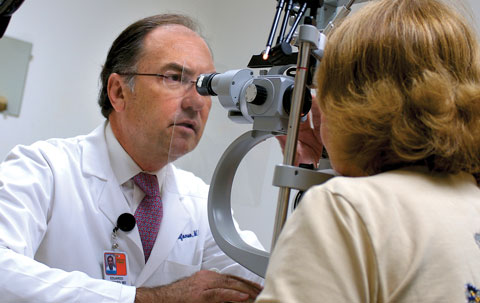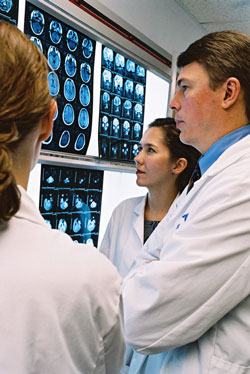In 1960 few would have bet that a 6-year-old boy forced to emigrate from Cuba, whose father had died at an early age of lung cancer, would one day become the leader of the best eye institute in the United States and beyond. His mother was warm and loving but not easy on her boys, and she was always enigmatic when answering their queries. Many of the answers Eddie Alfonso was looking for came from his education in a Jesuit school in Puerto Rico, where the family immigrated first. Young Eddie was blessed with great vision. That vision carried him all the way to the Ivy League, where he learned and developed a passion for medicine. It is the same vision that brought him to Miami to train in ophthalmology and become a master of the visual field.
 |
| Eduardo Alfonso, M.D., chair of world-renowned Bascom Palmer Eye Institute, conducts
an examination. |
As a young physician at the Bascom Palmer Eye Institute, Eddie—now married to his high school sweetheart, Molly, and with children Angelica, Patricia, and Eduardo—became fascinated by the vascular changes that were transforming the cornea, the layer of tissue that separates the eyeball from the outside world. The changes were triggered by the bacterial agent Treponema pallidum, the microorganism that causes syphilis (a condition called interstitial keratitis). Using laser light and photosensitizing dyes, he was able to block the progression of the otherwise irreversible blindness.
When a child hears about Peter’s Anomaly, they might think of Peter Pan but not of blindness due to a congenital condition where both corneas are opaque at birth. Many years ago, a couple consulted Dr. Alfonso about their 6-year-old daughter, who was suffering from the congenital condition. But the clock was ticking; by the age of 7, a blind child has missed the window of time to rehabilitate some vision, as the plasticity of the brain drops drastically at the level of the image processor. The decision was difficult because the tiny bit of vision she had left could have been jeopardized by a failed surgery. The corneal transplant was a success, and today that former patient is a rocket scientist at NASA. She can see to the end of the universe.
 |
| Steven J. Gedde, M.D., reviews images with former resident Vivian Schiedler, M.D. |
Nobody wants to have a fungus sharing contact lenses with their eyes. In the case of the fungus Fusarium, not only was it establishing residence in contact lenses but it was also feeding on nutrients that belong to our eyes. Eddie Alfonso and his team made the observation of an abnormally high prevalence of the infection and later discovered that a lens disinfecting and storage solution was the culprit, lowering the intrinsic ability of the eye to fight the infection and eventually helping the Fusarium to cause ulceration of the cornea. With more than 40 million contact lens users in the U.S., if Eddie and his fabulous team at the Miller School of Medicine had not made their discoveries, thousands of patients could have been affected and might have lost their vision.
The world of ophthalmology has changed substantially since Ed Norton created the Bascom Palmer Eye Institute, but his vision, carried and adapted by superstars like Eddie, is the reason why the institute is Number One in the U.S. and beyond.
“The new Ed Norton”—that is how Bascom Palmer colleagues describe Eddie. What it means is that Eddie has the vision to know where the field is moving and to take the institute to new heights. He never seeks to be the center of interest—he takes a back seat and allows the institute’s other outstanding physician-scientists to be successful and receive the rewards when a new breakthrough, a new medical milestone, is accomplished. Such a moment occurred in September when international media converged at Bascom Palmer to see the first U.S. patient whose sight was restored through modified osteo-odonto-keratoprosthesis (MOOKP). It’s a project Eddie’s been working on for about 15 years with Jean-Marie Parel, Ph.D., and Victor Perez, M.D. (See page 7 for a full story on the MOOKP procedure.)
Following in the path of Ed Norton means to be a role model but not brag about it—it means to be a mentor for all faculty and trainees along with the other outstanding mentors and role models of the institute. An example of mentoring that reflects the impact of being a young faculty member at Bascom, Steve Gedde grew up between two brothers and loving parents in a small Midwest farm town, Wauconda, Illinois. Steve was a good student who loved people and science and decided to become a physician. From Wesleyan University in Illinois, to Vanderbilt, to Wills Eye Hospital in Philadelphia, Dr. Steve Gedde, the first and only doc in his family, came to Bascom to do his fellowship. He had a particular interest in glaucoma, a condition that destroys the eye because of excess pressure (or more specifically the optic nerve) in about 2 percent of the U.S. population. With glaucoma experts at the institute like Doug Anderson, Paul Palmberg, Rich Parrish, Francisco Fantes, and Don Budenz, Steve Gedde learned from the best.
From learner to teacher, Steve is now at the helm of the premier ophthalmology training program. Under his watch, more than 300 residents and fellows have graduated from the program and taken leadership roles in the field, almost half of them in academic institutions. In addition to mentoring and teaching doctors and caring for patients, Steve is also performing groundbreaking research that will one day end the silent damage created by glaucoma. Steve, who did not get outside the walls of Bascom Palmer much, did not find just a professional opportunity there—he also met his wife, Yunhee Lee, a terrific eye surgeon. They have a son named Andrew who is 2 and learned everything there is to know about medicine in the blink of an eye.
Of Eddie taking the helm of Bascom Palmer, Steve says, “It is an all-time high for the institute, the future has never been more brilliant.”
From Cuba to Wauconda and elsewhere, the best women and men who have a passion for vision, in a very visual world, continue to come to the University of Miami Miller School of Medicine. The beautiful light of the sky falling on the big blue ocean … who could have guessed that one day vision and its preservation would be at its best at the Bascom Palmer Eye Institute. Little Andrew knows it and blinks his eyes…
|
 |
 |


